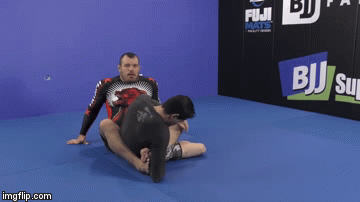
How do you escape a submission? Well, for starters you need to understand escapes, rather than submissions. Of course, you need to know what a heel hook is, but you do not need to be a member of Lachaln Giles’ gym in order to escape. It takes a bit of common sense, a concept of two, and plenty of reps. However, with heel hooks, there’s one more thing to consider – the psychological factor. They’ve been the boogeyman submission for so long, the people are often too afraid to actually try an escape a submission that’s easily defendable. Let’s demystify heel hook escapes, and look at several different options that will get you out of some of the tightest spots in Brazilian Jiu-Jitsu.
Yes, I know, heel hooks are scary! I agree, having one done to you, particularly by people that remind you of Toquinho is not fun. However, it is also not the end of the world. Yeah, Rousimar did not help the case against heel hooks, but then, they turned around and became an integral part of Jiu-Jitsu worldwide. It is hard to roll these days without having to fend off a leg attack or two. And leg locks, with heel hooks, in particular, are at that stage now, when everyone understands them, and they’re trying to figure out defenses.
The thing is, there’s nothing to figure out, There are easy ways of dealing with any leg lock imaginable, as we showed in a previous article. However, concepts are not always enough or appropriate for anyone. In that sense, let’s talk about submission escapes in general first, and then apply when we learn to heel hooks. A proven formula for success!
Leg Locks Are Not A Mystery Anymore
At a recent BJJ camp, I saw a white belt performing heel hooks at the level of a brown or black belt. It is obvious that he has only been doing one thing and one thing only. That said, what happens when he runs into someone who doesn’t tap? And I’m not talking about taking damage the way Miyao does, but rather, escaping in a Houdini-like fashion? You see, there’s a general formula for escapes that many people seem to disregard. Credits for this one go to Priit Mihkelson for explaining it so well.
When we learn defense we usually try and figure out how to escape while a move is taking place. Instead, at the highest level, this is where most escapes fail. What you need to focus on, if you want a solid escape plan against any and all submissions, is early and late defense. By early I mean not even getting in a position to defend in the first place. That was covered in an earlier article. By late, I mean an ultra-technical Hail Mary escape that works when everyone thinks you’re done for. This is exactly what we’ll be looking at today.
Let’s be honest, even though leg locks are not a mystery anymore, heel hook defenses and escapes are still hugely unknown. Of course, understanding how heel hooks work will help you figure out how to defend them. Still, you don’t have to know how they work in order to escape if you’re really not into it. All you need is to know when, how and what to focus on just when the opponent thinks you’ve got no way out. These are not just the most effective, but also the sweetest submission escapes you can do – they’ll leave everyone frustrated, and you safe.
Late Heel Hook Escapes: A Proven Formula
So, what’ this formula of late heel hook escapes that doesn’t fail? Well, it is all about knowing how to pressure the opponent’s grip, and when. To that extent, you do need to make sure you have an understanding of the types of heel hooks at the very least. As examples today, we’ll use an outside heel hook from the outside Ashi Grami position. Furthermore, we’ll look at an inside heel hook escape from the notorious 4/11 or Saddle. Finally, we’ll focus on the best way to beat the latest leg lock craze – Lachaln Giles’ 50/50 heel hook finish. In all of them, we’ll focus on late defense, meaning escaping at the very end of the motion. Risky, but extremely efficient and rewarding when you do it right.
1. Outside Heel Hook Escapes
Many people think the outside heel hook is inferior to the inside or inverted one. That’s a huge mistake. Remember that it is the position that makes the heel hooks, not the other way around. Speaking of the Outside Ashi, this position is really tough to deal with because the opponent can really pin your hip. Focusing on getting your hip out is a great way to forget all about the dangers of heel hooks and end up tapping in pain.

In the case of the outside Ashi game, you always have a free leg. The first thing you want to do is change the angle, even more, this time at the level of your hips. Simply scoot forward to take away lots of the leverage. Then, you’ll place the foot of your free leg on the opponent.s wrist. You’re aiming for the arm that has the grip around your heel. This renders the arm useless and you’re free to escape in any direction you want. After you pop your heel free, of course, the preferred direction is taking the back.
2. Inside Heel Hook Defense
This is the one most people get stuck with. Yes, there are effective heel hook escapes against the inside heel hook. And yes, they do work perfectly even when you’re stuck in the 4/11. In fact, you can even proceed to hunt for counter-heel hooks yourself once you get your leg fee. It is true that his position gives the submission a lot of power here. Moreover, the inside or inverted heel hook does pose a greater threat to many structures inside your knee joint and even ankle. SO make sure you always retain the option to tap as you’re learning the timing of this particular escape.

In this case, the angle doesn’t only release the tension on the submission but also allows you to thread the second leag through and do pretty much the same thing you did with the outside heel hook defense earlier. Once you’re out, the simplest solution is getting ga heel hook of your own, and you have both outside and inside options available.
3. 50/50 Heel Hook Escape

The first thing, once again, is the angle. This time though, you need to really be precise with it, because the heel hook comes strong, fast. The solution is simple- point your toes, like a ballerina towards the back. This pops the heel outside of your opponent’s grip. You then rotate and push with the leg in order to literally hide your foot behind their buttocks. From there on you can countre leg locks, try to go for a 50/50 pass or simply disengage from the position altogether.

Conclusion
There’s no need to fear any submission in Brazilian Jiu-Jitsu. You always have a 100% certain backup option – tap! And if you hate doing that, then simply choose to learn how defenses work. Look into early and late defenses, instead of lingering in the middle where most people focus. Although late heel hook escapes might seem like a bad idea, they’re actually very easy to do once you figure out all the angles. It does take practice, though, so make sure you train with someone that won’t rip your legs out while you’re learning these escapes. I guess rolling with Palhares is not an option…for now.


![Darce Choke Encyclopedia – Origins, Mechanics and Variations [2024] BJJ, choke, Brabo, BJJ Darce Choke, D'arce Choke, Darce BJJ Choke](https://bjj-world.com/wp-content/uploads/2017/11/JungPoirierLeeYahoo-218x150.jpg)










![Best Marcelo Garcia Techniques by Team Marcelo Garcia DVD Review [2025] Best Marcelo Garcia Techniques by Team Marcelo Garcia DVD Review](https://bjj-world.com/wp-content/uploads/2025/02/best-marcelo-garcia-techniques-dvd-review-218x150.png)
![Forging The De La Riva Guard Giancarlo Bodoni DVD Review [2025]](https://bjj-world.com/wp-content/uploads/2025/02/de-la-riva-guard-giancarlo-bodoni-dvd-review-218x150.png)

![Breaking Their Guard Mikey Musumeci DVD Review [2025] Breaking Their Guard Mikey Musumeci DVD Review](https://bjj-world.com/wp-content/uploads/2025/02/breaking-their-guard-mikey-musumeci-dvd-review-218x150.png)

![Breaking Their Guard Mikey Musumeci DVD Review [2025] Breaking Their Guard Mikey Musumeci DVD Review](https://bjj-world.com/wp-content/uploads/2025/02/breaking-their-guard-mikey-musumeci-dvd-review-324x235.png)



![Shin to Shin Eoghan O’Flanagan DVD Review [2025] Shin to Shin Eoghan O'Flanagan DVD Review](https://bjj-world.com/wp-content/uploads/2024/12/shin-to-shin-eoghan-oflanagan-dvd-review-100x70.png)


![Reverse De La Riva System Mikey Musumeci DVD Review [2024] Reverse De La Riva System Mikey Musumeci DVD Review](https://bjj-world.com/wp-content/uploads/2024/11/reverse-de-la-riva-system-mikey-musumeci-dvd-review-100x70.png)
![Full Guard Formula James Booth DVD Review [2025] Full Guard Formula James Booth DVD Review](https://bjj-world.com/wp-content/uploads/2025/02/full-guard-formula-james-booth-dvd-review-100x70.png)
![Master The Move Anaconda Strangle John Danaher DVD Review [2025] Master The Move Anaconda Strangle John Danaher DVD Review](https://bjj-world.com/wp-content/uploads/2025/02/anaconda-strangle-john-danaher-dvd-review-100x70.png)

![Roger Gracie Guard Passing System DVD Review [2025] Roger Gracie Guard Passing System DVD Review](https://bjj-world.com/wp-content/uploads/2025/02/roger-gracie-guard-passing-system-dvd-review-100x70.png)


![Heavy Top Game Fabiano Scherner BJJ DVD Review [2025] Heavy Top Game Fabiano Scherner BJJ DVD Review](https://bjj-world.com/wp-content/uploads/2025/01/heavy-top-game-fabiano-scherner-bjj-dvd-review-100x70.png)
![Tiny Woman Guide To The Guard Ann Kneib DVD Review [2024] Tiny Woman Guide To The Guard Ann Kneib DVD Review](https://bjj-world.com/wp-content/uploads/2024/11/tiny-woman-guide-to-the-guard-ann-kneib-dvd-review-100x70.png)


![Finish on the Back Ethan Crelinsten DVD Review [2024] Finish on the Back Ethan Crelinsten DVD Review](https://bjj-world.com/wp-content/uploads/2024/10/finish-on-the-back-ethan-crelinsten-dvd-review-100x70.png)


![Efficiently Executing X-Guard Giancarlo Bodoni DVD Review [2024] Efficiently Executing X-Guard Giancarlo Bodoni DVD Review](https://bjj-world.com/wp-content/uploads/2024/09/efficiently-executing-x-guard-giancarlo-bodoni-dvd-REVIEW-100x70.png)



![360 Degrees Guard Retention Thiago Abud DVD Review [2024] 360 Degrees Guard Retention Thiago Abud DVD Review](https://bjj-world.com/wp-content/uploads/2024/10/360-degrees-guard-retention-thiago-abud-dvd-review-100x70.png)
![Systematically Attacking The Crucifix Gordon Ryan DVD Review [2024] Systematically Attacking The Crucifix Gordon Ryan DVD Review](https://bjj-world.com/wp-content/uploads/2024/10/systematically-attacking-the-crucifix-gordon-ryan-dvd-review-100x70.png)
